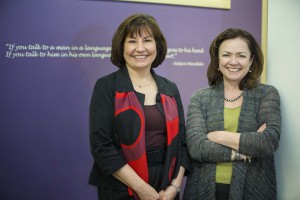Research is what brought language immersion educators Dee Tedick and Tara Fortune together in the early 1990s. Tedick had recently joined the Department of Curriculum and Instruction when Fortune began graduate school.
Both had been drawn to immersion research by personal experiences. Tedick, with a degree in Spanish and education, had moved to Spain and was giving private English lessons to three biology majors who needed English to read biology texts.

“This light bulb went off in my head,” Tedick remembers. “It was so much more interesting to teach English through subject matter, and so much more interesting for them to learn.”
Fortune, the daughter of a naval officer, spent her first year of life in Japan. Her language learning began in fifth grade Spanish with Don Miguel on TV, then Latin in high school, and Hebrew, Greek, and more Latin in college. It was almost by accident that she began learning German in her junior year.
“I became interested in these two diametrically opposed ways I had learned and taught world languages—traditional grammar translation versus in-country ‘immersion’ where I learned the language in the language,” says Fortune. “I wanted to understand why my German was better after six months in southwest Germany than my Latin after six years of classroom study.”
In graduate school, Fortune worked as a research assistant with her adviser, Helen Jorstad, on a national survey of U.S. immersion programs funded by the Center for Advanced Research on Language Acquisition (CARLA), then a new center. For her master’s thesis, Fortune studied private bilingual and international schools in Mexico City.
“I saw that immersion programs in the United States were really making available to the public something that had been available in other countries and to the elite for a very long time—centuries, if not more,” says Fortune.
When she decided to go on for her Ph.D., Fortune committed herself to investigating and supporting educators with language immersion education and asked Tedick to be her adviser. They have worked together ever since.
On the move
Tedick teaches, conducts research, advises students who focus on immersion, and co-edits an international journal on immersion education that she recently co-founded. She points to CEHD’s curriculum, continually developing under her leadership to meet the needs of immersion educators and schools (see below). On a sabbatical year, she worked with Minneapolis Public Schools to develop smooth curricular transitions between preK–5 immersion programs at Windom and Emerson schools and the continuation program at Anwatin as it prepared to reorganize into a middle school. This February, she testified at the legislature on teacher preparation for dual language and immersion settings. Her work with the national and international immersion communities includes Indigenous programs in Hawaii and Alaska, and last fall she represented the United States at an international seminar on immersion teacher education in Finland. In May, she will deliver a plenary speech at an immersion conference in Brazil.
At the same time, Fortune has worked with the growing network of immersion schools and educators in Minnesota and around the world, disseminating research, identifying and spreading best practices, and pinpointing new areas for research. She delivers summer training institutes, consults in communities, and has given keynote presentations at conferences in California, Texas, and Canada on immersion learners and struggling language learners. In September, she was invited to co-represent the United States at the East Asia Summit Conference on Bilingualism in Singapore, and she’ll speak in France in October.
“If there is one thing we have learned, it is that no one immersion program model works in every community,” says Fortune. “The key is implementation.”
Learn more about immersion education at CEHD on the Department of Curriculum and Instruction website, and watch a video about immersion education in Minnesota on CARLA’s immersion webpage.
Read the feature story, “A state of immersion,” in this issue of Connect.
Story by Gayla Marty | Photo by Greg Helgeson | Spring/Summer 2014